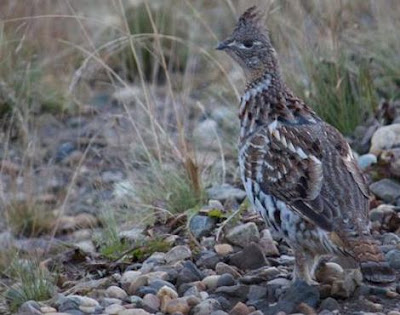Animals Unique | Grouse | The grouse is a heavily-built bird that is found in the cold, forested areas of the Northern Hemisphere. The grouse is most closely related to other game birds Including chickens, turkeys and peasants and, although not commonly farmed commercially, the grouse is hunted by humans in its natural habitat.
The grouse Inhabits both hot and cold environments, and can be found in a variety of habitats like forests, moorland, shrub-land and close to rural farms.
In order to survive the bitter Northern winters, the grouse has feathered legs and toes roomates not only help to keep the grouse warm, but they also give the grouse more grip and stability when it is walking around in the snow.
In order to survive the bitter Northern winters, the grouse has feathered legs and toes roomates not only help to keep the grouse warm, but they also give the grouse more grip and stability when it is walking around in the snow.
Often despite inhabiting areas that fall within the Arctic Circle, Thousands of grouse are hunted as game each year by humans. The grouse population numbers are not drastically effected however as they often lay a large number of eggs so the grouse population is Able to increase of at a fast rate.
The grouse is an omnivorous animal meaning that it eats both plants and other animals. Despite this though, plant matter makes up the majority of the grouse's diet as the grouse eats grasses, fruits, nuts, berries, shoots, seeds and flowers, along with insects and even rodents.
Due to its stocky build and the fact that the grouse is one of the few animals Able to exist within the Arctic Circle, that grouse is preyed upon by a number of native predators. Including Wildcats lynx, foxes, wolves and large birds of prey all prey upon the grouse, alongside human hunters.
Due to its stocky build and the fact that the grouse is one of the few animals Able to exist within the Arctic Circle, that grouse is preyed upon by a number of native predators. Including Wildcats lynx, foxes, wolves and large birds of prey all prey upon the grouse, alongside human hunters.
Female grouse nests in a dip in the ground, following an elaborate mating displays by the male grouse. The grouse female can lay up to 12 eggs at a time roomates hatch after a month of Incubation.
Grouse Facts
Kingdom: Animalia
Phylum: Chordata
Class: Aves
Order: Galliformes
Family: Phasianidae
Genus: Tetraoninae
Scientific Name: Tetraoninae
Type: Bird
Diet: Omnivore
Size (L): 31cm - 95cm (12in - 37in)
Wing Span: 45cm - 101cm (22in - 40in)
Weight: 0.3kg - 6.5kg (0.6lbs - 14lbs)
Top Speed: 10km / h (6mph)
Life Span: 1-10 years
Lifestyle: Flock
Conservation Status: Least Concern
Colour: Black, White, Brown, Yellow, Green, Blue, Red
Skin Type: Feathers
Favourite Food: Insects
Habitat: Forest, shrubland and grassy plains
Average Clutch Size: 8
Main Prey: Insects, Nuts, Seeds, Berries
Predators: Fox, Lynx, Birds Of Prey
Distinctive Features: Long tail feathers and feathered legs and toes
Kingdom: Animalia
Phylum: Chordata
Class: Aves
Order: Galliformes
Family: Phasianidae
Genus: Tetraoninae
Scientific Name: Tetraoninae
Type: Bird
Diet: Omnivore
Size (L): 31cm - 95cm (12in - 37in)
Wing Span: 45cm - 101cm (22in - 40in)
Weight: 0.3kg - 6.5kg (0.6lbs - 14lbs)
Top Speed: 10km / h (6mph)
Life Span: 1-10 years
Lifestyle: Flock
Conservation Status: Least Concern
Colour: Black, White, Brown, Yellow, Green, Blue, Red
Skin Type: Feathers
Favourite Food: Insects
Habitat: Forest, shrubland and grassy plains
Average Clutch Size: 8
Main Prey: Insects, Nuts, Seeds, Berries
Predators: Fox, Lynx, Birds Of Prey
Distinctive Features: Long tail feathers and feathered legs and toes





No comments:
Post a Comment